Industrial machinery with high horsepower and
high loads, such as steam turbines, centrifugal compressors, pumps and motors, utilize
journal bearings as rotor supports.
One of the basic purposes of a bearing is to provide
a frictionless environment to support and guide a rotating shaft. Properly installed and
maintained, journal bearings have essentially infinite life.
Bearing Design
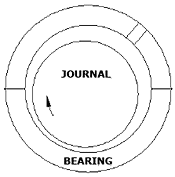
A
journal bearing, simply stated, is a cylinder which surrounds the shaft and is filled with
some form of fluid lubricant. In this bearing a fluid is the medium that supports the
shaft preventing metal to metal contact. The most common fluid used is oil, with special
applications using water or a gas. This application note will concentrate on oil
lubricated journal bearings.
Hydrodynamic principles, which are active as the shaft rotates, create an oil
wedge that supports the shaft and relocates it within the bearing clearances. In a
horizontally split bearing the oil wedge will lift and support the shaft, relocating the
centerline slightly up and to one side into a normal attitude position in a lower quadrant
of the bearing. The normal attitude angle will depend upon the shaft rotation direction
with a clockwise rotation having an attitude angle in the lower left quadrant. External
influences, such as hydraulic volute pressures in pumps or generator electrical load can
produce additional relocating forces on the shaft attitude angle and centerline position.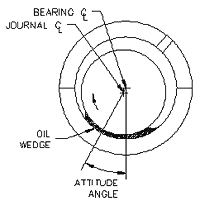
An additional characteristic of journal bearings is damping. This type of bearing
provides much more damping than a rolling element bearing because of the lubricant
present. More viscous and thicker lubricant films provide higher damping properties. As
the available damping increases, the bearing stability also increases. A stable bearing
design holds the rotor at a fixed attitude angle during transient periods such as machine
startups/shutdowns or load changes. The damping properties of the lubricant also provides
an excellent medium for limiting vibration transmission. Thus, a vibration measurement
taken at the bearing outer shell will not represent the actual vibration experienced by
the rotor within its bearing clearances.
Journal bearings have many differing designs to compensate for differing load
requirements, machine speeds, cost, or dynamic properties. One unique disadvantage which
consumes much research and experimentation is an instability which manifests itself as oil
whirl and oil whip. Left uncorrected, this phenomenon is catastrophic and can destroy the
bearing and rotor very quickly. Oil whip is so disastrous because the rotor cannot form a
stable oil wedge consequently allowing metal to metal contact between the rotor and the
bearing surface. Once surface contact exists the rotor begins to precess, in a reverse
direction from rotor rotation direction, using the entire bearing clearance. This
condition leads to high friction levels which will overheat the bearing babbit metal that
leads to rapid destruction of the bearing, rotor journal, and the machine seals.
Some common designs employed are lemon bore, pressure dam, and tilt pad bearings. These
designs were developed to interrupt and redirect the oil flow path within the bearing to
provide higher bearing stabilities.
Geometries
Journal bearings installed in industrial machinery today generally fall into two
categories: full bearings and partial arc bearings. Full bearings completely surround the
shaft journal with many differing geometries such as elliptical, lobed, or pressure dam
configurations and usually are two pieces, mated at a split line. Partial arc bearings
have several individual load bearing surfaces or pads and are made up of numerous
adjustable components.
The bearing inner surface is covered with a softer material, commonly called babbit.
Babbit, which is a tin or lead based alloy, has a thickness that can vary from 1 to 100
mils depending upon the bearing diameter. A babbit lining provides a surface which will
not mar or gouge the shaft if contact is made and to allow particles in the lubricant to
be imbedded in the liner without damaging the shaft.
Plain Bearing
The plain bearing is the simplest and most common design with a high load carrying
capacity and the lowest cost. This bearing is a simple cylinder with a clearance of about
1-2 mils per inch of journal diameter. Due to its cylindrical configuration it is the most
susceptible to oil whirl. It is a fairly common practice during installation to provide a
slight amount of "crush" to force the bearing into a slightly elliptical
configuration.
Lemon Bore
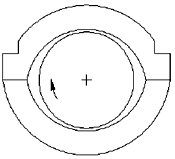
The
lemon or elliptical bore bearing is a variation on the plain bearing where the bearing
clearance is reduced on one direction. During manufacture this bearing has shims installed
at the split line and then bored cylindrical. When the shims are removed the lemon bore
pattern is results. For horizontally split bearings, this design creates an increased
vertical pre-load onto the shaft.
This bearing has a lower load carrying capacity that plain bearings, but are still
susceptible to oil whirl at high speeds. Manufacturing and installation costs are
considered low.
Pressure Dam
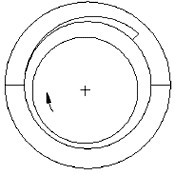
A pressure
dam bearing is basically a plain bearing which has been modified to incorporate a central
relief groove or scallop along the top half of the bearing shell ending abruptly at a
step. As the lubricant is carried around the bearing it encounters the step that causes an
increased pressure at the top of the journal inducing a stabilizing force onto the journal
which forces the shaft into the bottom half of the bearing.
This bearing has a high load capacity and is a common correction for machine designs
susceptible to oil whirl. Pressure dam bearings are a unidirectional configuration.
Another unidirectional bearing configuration is the offset bearing. It is similar to a
plain bearing, but the upper half has been shifted horizontally. Offset bearings have
increasing load capacities as the offset is increased.
Tilting Pad
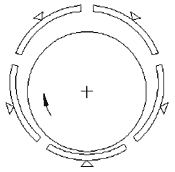
Tilting
pad bearings is a partial arc design. This configuration has individual bearing pads which
are allowed to pivot or tilt to conform with the dynamic loads from the lubricant and
shaft. This type of bearing is a unidirectional design and is available in several
variations incorporating differing numbers of pads with the generated load applied on a
pad or between the pads.
Vibration Monitoring
A shaft supported by journal bearings will move relative to the bearing housing as various
forces are imposed onto the shaft. A vibration transducer is required which can monitor
the relative motion between the shaft and the bearing. Higher vibration frequencies are
not of prime concern since they would not be transmitted through the oil film reliably.
The only sensor available that can measure relative measurements of the shaft is the
non-contacting pickup, sometimes called a displacement, eddy current, or proximity pickup.
This type of sensor measures the relative vibration of the shaft and, also, the relative
position of the shaft with respect to the bearing clearances. High frequencies such as
blade passage and cavitation would be attenuated by the lubricant. Case mounted sensors
would not provide an accurate indication of the vibration due to the inherent damping
offered by the lubricant between the shaft and the bearing. For more information about
installation and theory of operation of NCPUs, see the STI Application Notes: Eddy Current
Transducer Installation, Part 1-Radial Vibration.
|

